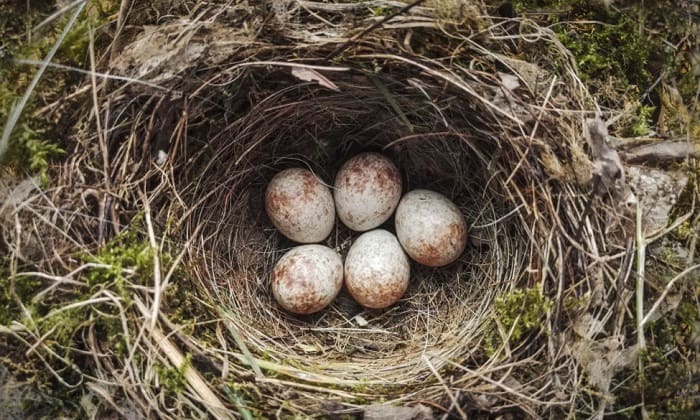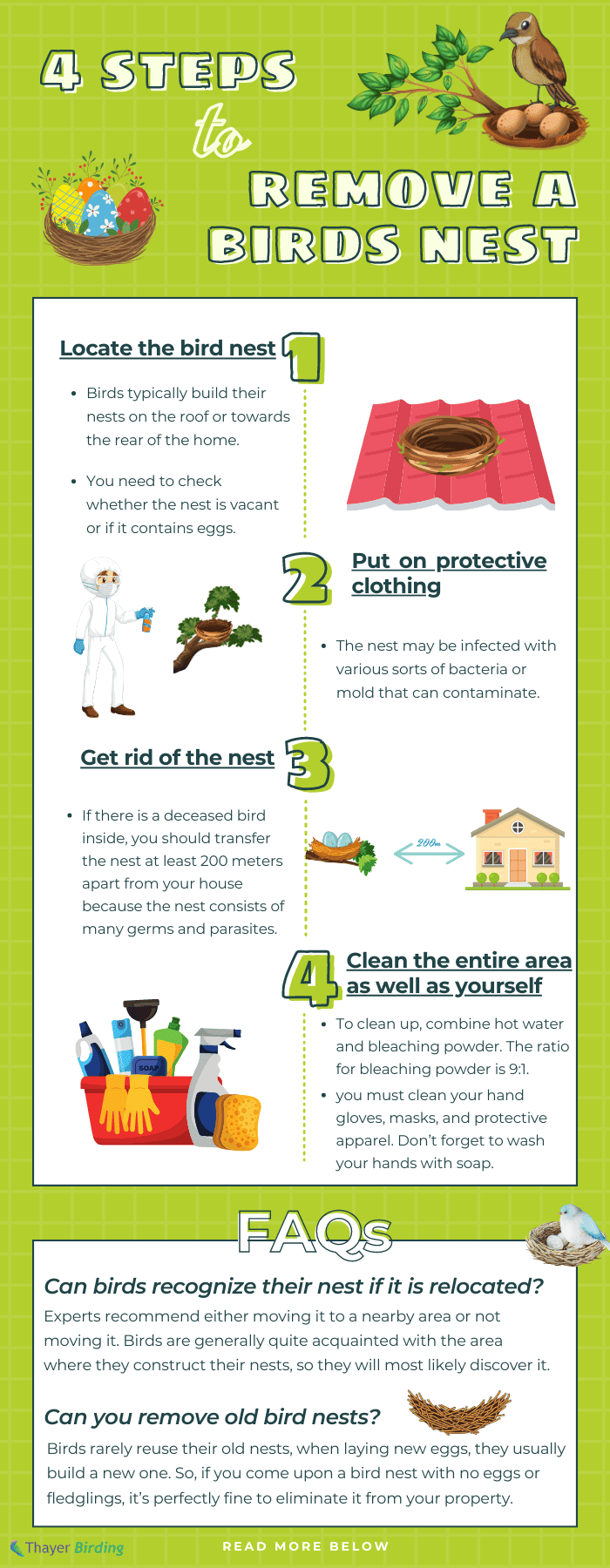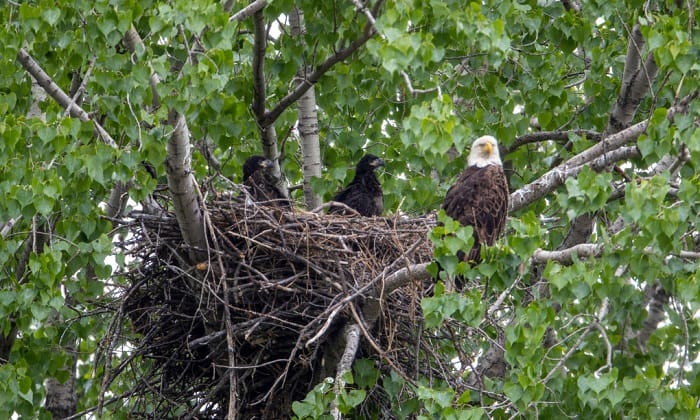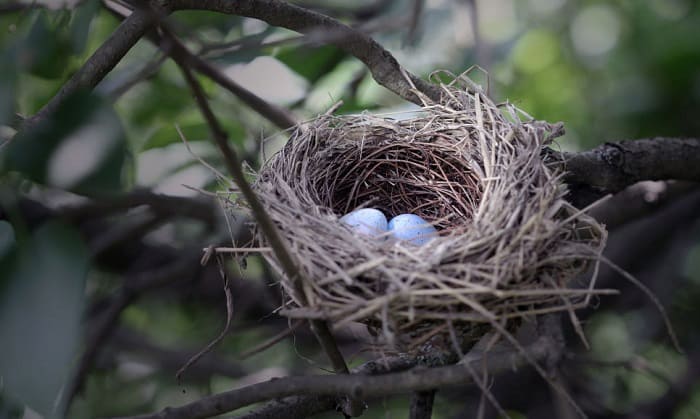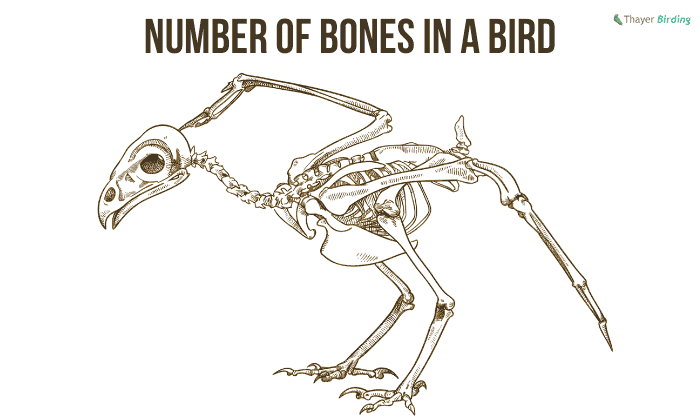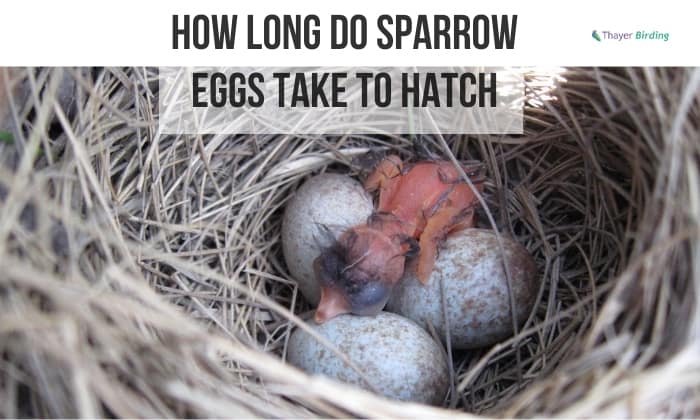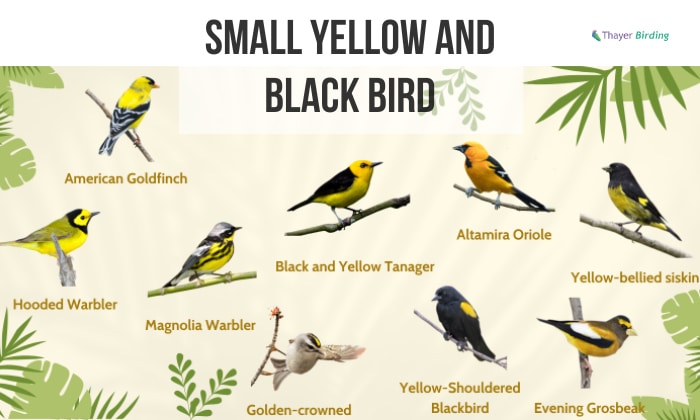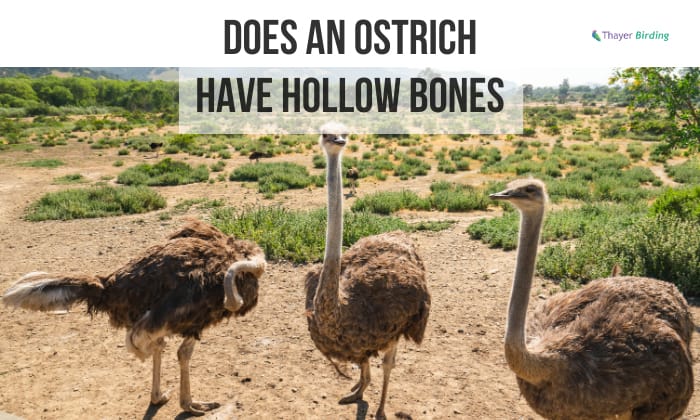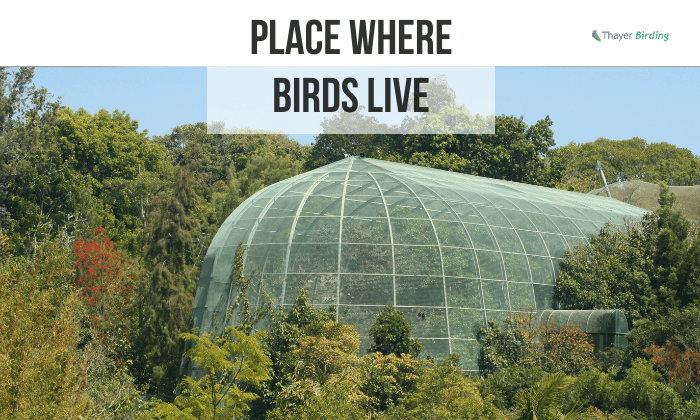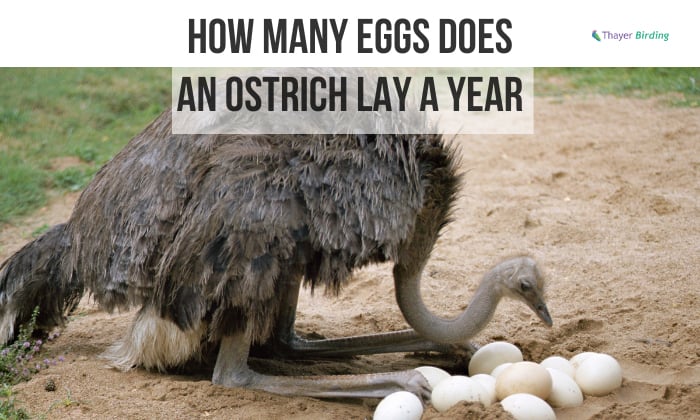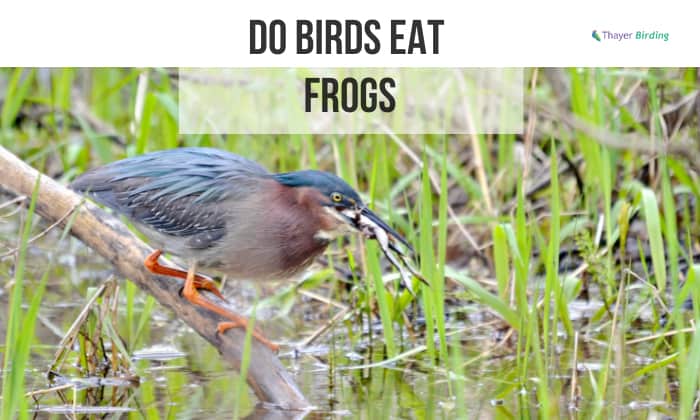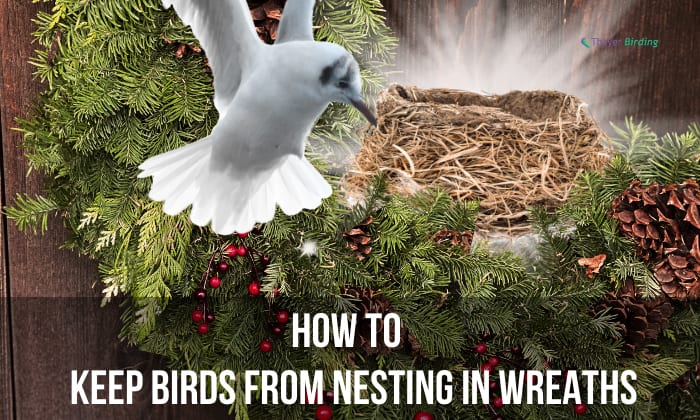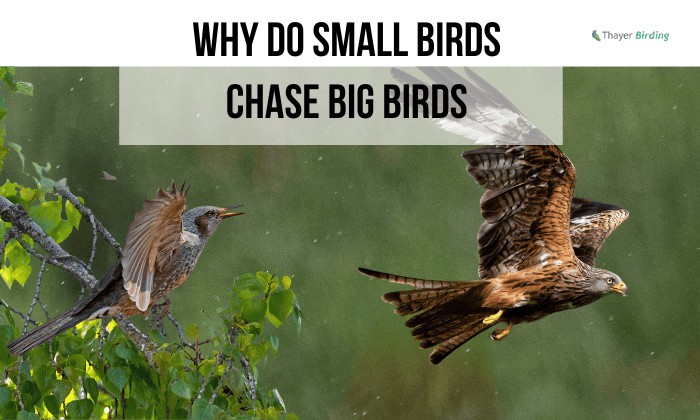Bird nests are essential to birds because they provide a secure, warm, and cozy environment to lay and nurture eggs. During the first several months after birth, the hatchlings will spend their time in a nest.
Nevertheless, birds do not always make their homes in the most convenient locations for people, and as a result, people have to get rid of them. In case you find an egg-filled bird nest, what should you do?
In this article, we will find out more about how to remove a birds nest with eggs. If you want to relocate the nest, you should do it once they hatch. If you move a bird nest while the eggs are still in the nest, their parents may leave them. Furthermore, it is prohibited to get rid of birds nests, so you must be careful.
Table of Contents
Is Moving a Bird’s Nest with Eggs Safe and Legal
Birds build their nests using spider silk, grasses, dandelions, or dried leaves. Bird droppings including acid can deteriorate properties by speeding up the rusting. Also, bird droppings create many harmful bacteria that cause many diseases for humans.
Moreover, the dead bird’s corpse contains histoplasmosis, causing respiratory concern. Due to these reasons, people sometimes have to get rid of bird nests. However, before removing or relocating a birds’ nest, check if it is legal in your country.
At your property, you may have come across an egg-filled bird’s nest. If you care about the bird’s well-being and do not want to do anything unlawful, you should not move the nest while the eggs are still within it. It is preferable to remove a bird’s nest before the birds have finished building it, when the nest is still in its early days.
On the other hand, experts recommend delaying nest removal until the eggs have hatched and the young birds have fled the nest. Disturbing or relocating a bird’s nest containing eggs usually results in the parent bird abandoning the nest.
In the United States, up to 500 birds and their eggs are under protection of the Federal Migratory Bird Treaty Act. It is unlawful to damage or demolish the nests before the end of the breeding season. Only after the breeding season has ended (no eggs or chicks in the nest), are you allowed to remove the nest.
This means that even when the nest is causing problems, there is not much you can do about it. If you’re having difficulties relocating a bird’s nest, get in touch with a local wildlife rehabilitator to avoid breaching the law. They may recognize your condition and allow you to relocate the bird’s nest.
Warning!
There are some nests that should never be eliminated unless wildlife officials have been contacted or there are no other viable solutions to protecting the nesting birds. Among these nests are: endangered species that are unlikely to rebuild their nest if being interrupted, large birds’ nests like eagles or raptors that may be reused for years, and nests that are too dangerous for humans to approach.
How to Relocate a Bird’s Nest with Eggs
If you have permission from the wildlife rehabilitator, remove the nest using the four steps listed below.
Step 1: Locate the bird nest
Birds typically build their nests on the roof or towards the rear of the home. You need to check whether the nest is vacant or if it contains eggs. You may check with a ladder to see if the nesting is too high off the ground. To remove bacteria, specialists advise spraying the house with an antibacterial spray. After spraying the nest, you should wait a bit.
Step 2: Put on protective clothing
When removing bird nests, you must be extremely cautious. Small bugs may be difficult to notice in the nesting material, or the nest may be infected with various sorts of bacteria or mold that can contaminate. To prevent risks from harmful microorganisms, you should use masks, gloves, and other protective equipment. You should also wear a long-sleeved shirt and pants.
Step 3: Get rid of the nest
After donning protective gear, it is time to dismantle the bird’s nest. You can now get rid of the nest and shift it to a spot where you won’t have any problems with it. However, if there is a deceased bird inside, you should transfer the nest at least 200 meters apart from your house because the nest consists of many germs and parasites.
You should dispose of the abandoned nest in a compost bin or in a garbage bag, if possible, to keep predators away from the nesting location, where fledglings may still be in danger.
As soon as the nest has been removed, you must disinfect the area. This is critical to avoid health consequences.
Step 4: Clean the entire area as well as yourself
Following the removal of the bird’s nest, the area must be properly cleaned because there might be bird excrement, which spreads numerous illnesses. To clean up, combine hot water and bleaching powder. The ratio for bleaching powder is 9:1.
Now, you must clean your hand gloves, masks, and protective apparel. Don’t forget to wash your hands with soap. You should take a shower as well.
Can Birds Recognize Their Nest If It is Relocated
If you are concerned with the location of a bird’s nest and want to do anything about it, experts recommend either moving it to a nearby area or not moving it. Birds are generally quite acquainted with the area where they construct their nests, so they will most likely discover it. However, if you move the nest further away from where it previously was, the bird may not be able to find it.
Do Birds Leave Their Nest if You Touch It
Birds, unlike dogs and cats, do not possess a strong sense of smell and will not notice if a human touches their nest when they are away. However, if a bird notices you going close to or touching its nest, it will most likely leave the nest, even if it contains eggs or babies. Birds may construct their nests near humans, but it doesn’t mean they aren’t afraid of us.
How to Prevent Birds from Nesting in Unwanted Spots
If you don’t want birds revisiting the same place after you’ve dismantled a nest, you’ll need to take precautions to keep them away. To prevent nesting, change the contour of the place where the birds used to build their nest by installing a slant board or spikes.
You may create the illusion of danger by placing decoys like cats, snakes, and owls near the nesting location. Your attentiveness will be essential at the start of the breeding season, and destroying nests before they are finished would encourage birds to seek a different place to take care of their families.
Can You Remove Old Bird Nests
There are no regulations prohibiting the destruction of empty or abandoned bird nests. Moreover, birds rarely reuse their old nests, when laying new eggs, they usually build a new one. So, if you come upon a bird nest with no eggs or fledglings, it’s perfectly fine to eliminate it from your property.
Conclusion
Who doesn’t enjoy birds singing in the backyard? Some people are even delighted when birds raise their families in the garden. Nevertheless, birds sometimes make their homes at undesirable locations and interfere with human’s daily activities, so people have to remove them.
Additionally, birds and bird nests transfer health risks to humans. Moving a bird’s nests with eggs seems to be simple but it requires legality. Therefore, remember to check with the local wildlife rehabilitator before doing it.
We hope you find this helpful for guiding you on how to remove a birds nest with eggs. If you want to know more about bird’s nests removal, leave us comments!
Besides, you also can refer more to our other articles that related to ways to get rid of birds:

George and I became friends after a birdwatching trip with our new group. And we have been enjoying every adventure together. When he told me the idea of establishing a site that shares our experiences and fun, I immediately agreed. After trials and errors, here we have Thayerbirding.


